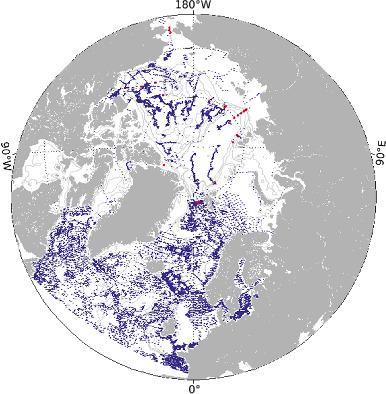当前位置:
X-MOL 学术
›
Q. J. R. Meteorol. Soc.
›
论文详情
Our official English website, www.x-mol.net, welcomes your
feedback! (Note: you will need to create a separate account there.)
Assessing the current and future Arctic Ocean observing system with observing system simulating experiments
Quarterly Journal of the Royal Meteorological Society ( IF 3.0 ) Pub Date : 2021-04-29 , DOI: 10.1002/qj.4044 Guokun Lyu 1, 2 , Armin Koehl 1 , Nuno Serra 2 , Detlef Stammer 1
Quarterly Journal of the Royal Meteorological Society ( IF 3.0 ) Pub Date : 2021-04-29 , DOI: 10.1002/qj.4044 Guokun Lyu 1, 2 , Armin Koehl 1 , Nuno Serra 2 , Detlef Stammer 1
Affiliation

|
Arctic Ocean Observing System Simulation Experiments (OSSEs) were performed with a pan-Arctic coupled ocean–sea ice data assimilation system to assess the impacts of assimilating available observations on the Arctic ocean–sea ice state. To this end, the adjoint method with a 3-year assimilation window was used to assimilate synthetic observations sampled from a 4 km model simulation at the spatio-temporal distribution of the existing observing system. After data assimilation, the sea ice state, including sea ice concentration (SIC), sea ice thickness (SIT), and sea ice volume (SIV), were significantly improved, benefiting from the high spatio-temporal coverage of SIC observations and the wintertime SIT observations. In contrast, the ocean state is not very well constrained with the existing hydrographic observing system. An additional 1° × 1° ocean profiling array with a 10-day sampling frequency was seen to substantially improve the estimated ocean temperature and freshwater content. Data from additional moorings deployed in the Fram Strait and continental slope of the Laptev Sea could also improve the pathway of Atlantic inflow to the Arctic Ocean and the temperature of the Atlantic inflow but degrade the mean volume transport through the Fram Strait. Moreover, estimated exchanges between the Arctic Ocean and the Atlantic Ocean through the Fram Strait, Davis Strait and the St. Anna Trough were found to benefit from the high-density profiling array.
中文翻译:

用观测系统模拟实验评估当前和未来的北冰洋观测系统
北冰洋观测系统模拟实验 (OSSE) 使用泛北极耦合海洋-海冰数据同化系统进行,以评估同化可用观测对北冰洋-海冰状态的影响。为此,使用具有 3 年同化窗口的伴随方法同化从现有观测系统时空分布的 4 公里模式模拟中采样的合成观测。数据同化后,得益于SIC观测的高时空覆盖和冬季,海冰状态,包括海冰浓度(SIC)、海冰厚度(SIT)和海冰体积(SIV)得到显着改善。 SIT 观察。相比之下,海洋状态不受现有水文观测系统的很好限制。一个额外的 1° × 1° 海洋剖面阵列,采样频率为 10 天,可以显着提高估计的海洋温度和淡水含量。来自在弗拉姆海峡和拉普捷夫海大陆坡部署的额外系泊设施的数据也可以改善大西洋流入北冰洋的路径和大西洋流入的温度,但会降低通过弗拉姆海峡的平均流量。此外,通过弗拉姆海峡、戴维斯海峡和圣安娜海槽估计的北冰洋和大西洋之间的交换被发现受益于高密度剖面阵列。来自在弗拉姆海峡和拉普捷夫海大陆坡部署的额外系泊设施的数据也可以改善大西洋流入北冰洋的路径和大西洋流入的温度,但会降低通过弗拉姆海峡的平均流量。此外,通过弗拉姆海峡、戴维斯海峡和圣安娜海槽估计的北冰洋和大西洋之间的交换被发现受益于高密度剖面阵列。来自在弗拉姆海峡和拉普捷夫海大陆坡部署的额外系泊设施的数据也可以改善大西洋流入北冰洋的路径和大西洋流入的温度,但会降低通过弗拉姆海峡的平均流量。此外,通过弗拉姆海峡、戴维斯海峡和圣安娜海槽估计的北冰洋和大西洋之间的交换被发现受益于高密度剖面阵列。
更新日期:2021-04-29
中文翻译:

用观测系统模拟实验评估当前和未来的北冰洋观测系统
北冰洋观测系统模拟实验 (OSSE) 使用泛北极耦合海洋-海冰数据同化系统进行,以评估同化可用观测对北冰洋-海冰状态的影响。为此,使用具有 3 年同化窗口的伴随方法同化从现有观测系统时空分布的 4 公里模式模拟中采样的合成观测。数据同化后,得益于SIC观测的高时空覆盖和冬季,海冰状态,包括海冰浓度(SIC)、海冰厚度(SIT)和海冰体积(SIV)得到显着改善。 SIT 观察。相比之下,海洋状态不受现有水文观测系统的很好限制。一个额外的 1° × 1° 海洋剖面阵列,采样频率为 10 天,可以显着提高估计的海洋温度和淡水含量。来自在弗拉姆海峡和拉普捷夫海大陆坡部署的额外系泊设施的数据也可以改善大西洋流入北冰洋的路径和大西洋流入的温度,但会降低通过弗拉姆海峡的平均流量。此外,通过弗拉姆海峡、戴维斯海峡和圣安娜海槽估计的北冰洋和大西洋之间的交换被发现受益于高密度剖面阵列。来自在弗拉姆海峡和拉普捷夫海大陆坡部署的额外系泊设施的数据也可以改善大西洋流入北冰洋的路径和大西洋流入的温度,但会降低通过弗拉姆海峡的平均流量。此外,通过弗拉姆海峡、戴维斯海峡和圣安娜海槽估计的北冰洋和大西洋之间的交换被发现受益于高密度剖面阵列。来自在弗拉姆海峡和拉普捷夫海大陆坡部署的额外系泊设施的数据也可以改善大西洋流入北冰洋的路径和大西洋流入的温度,但会降低通过弗拉姆海峡的平均流量。此外,通过弗拉姆海峡、戴维斯海峡和圣安娜海槽估计的北冰洋和大西洋之间的交换被发现受益于高密度剖面阵列。











































 京公网安备 11010802027423号
京公网安备 11010802027423号